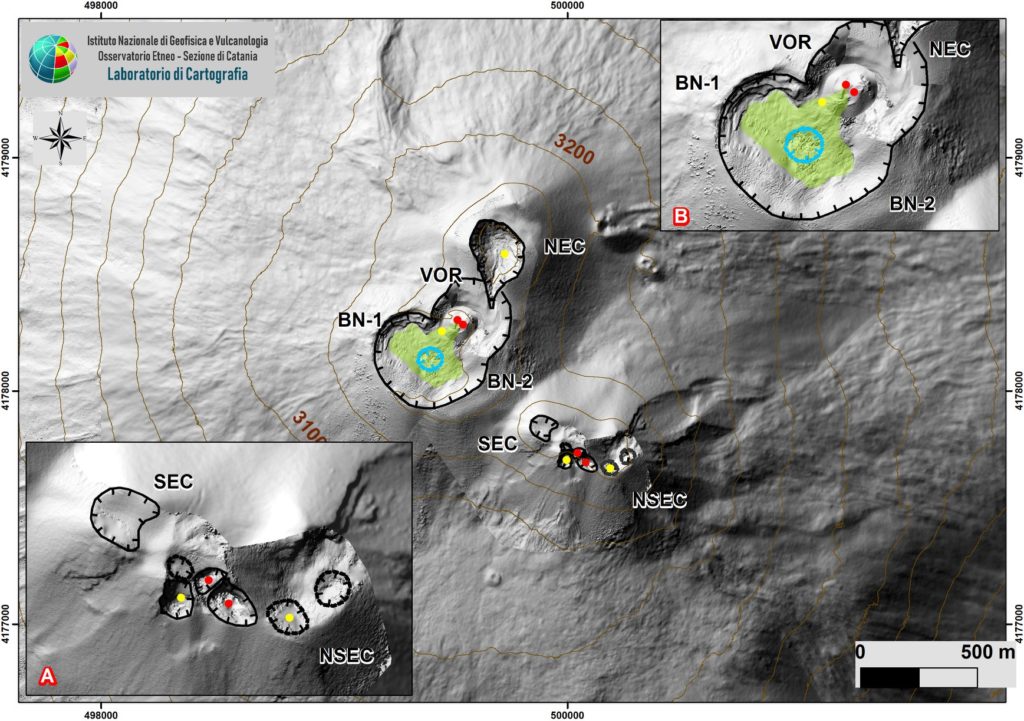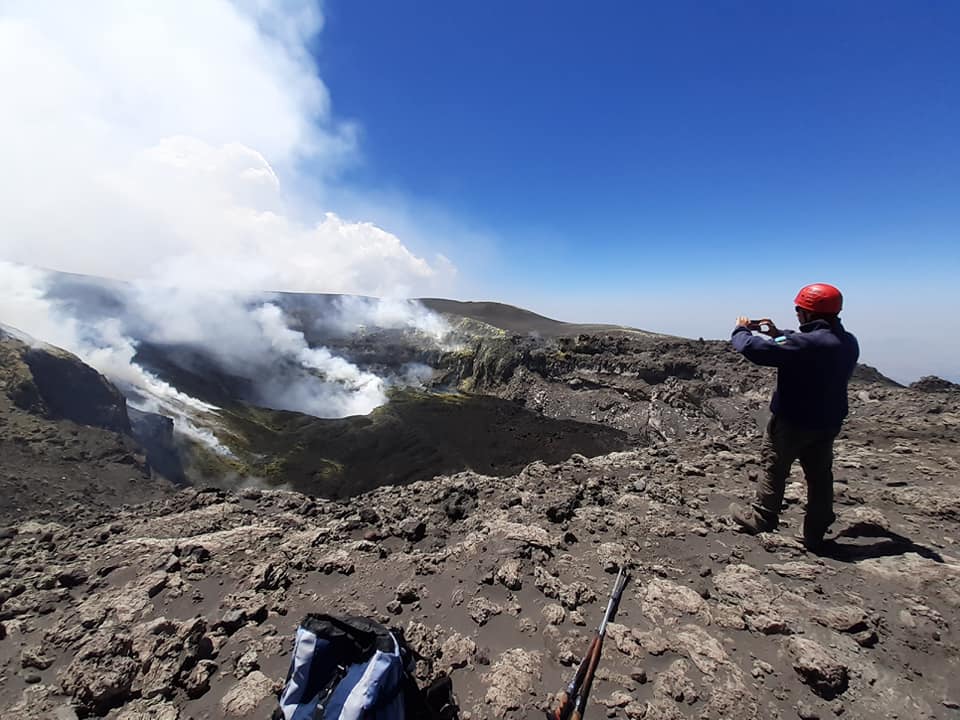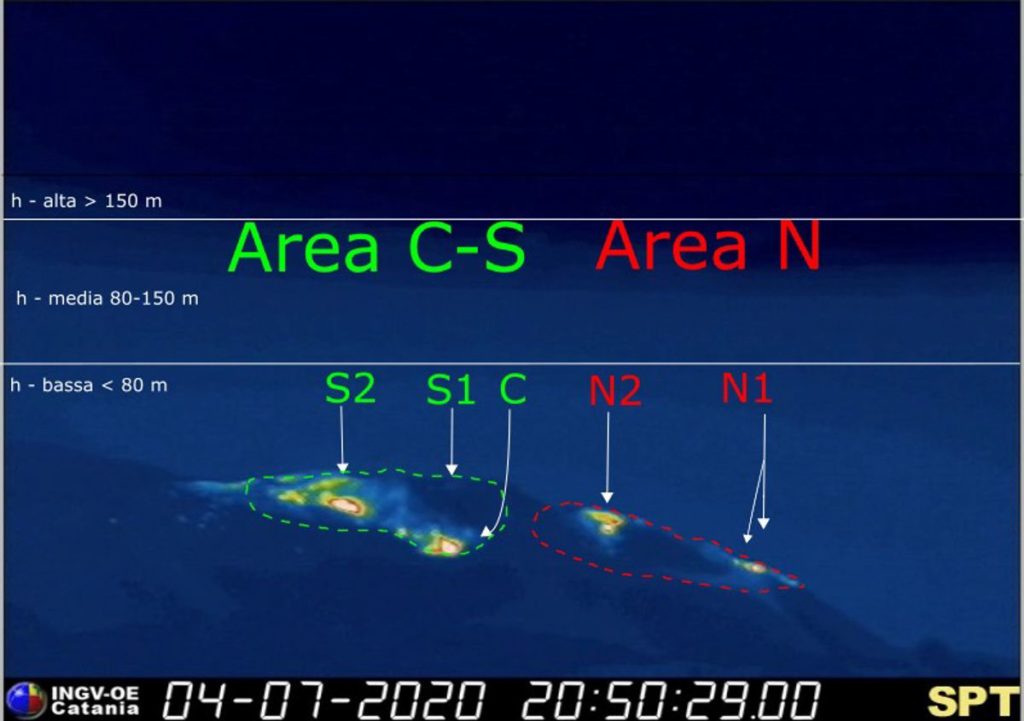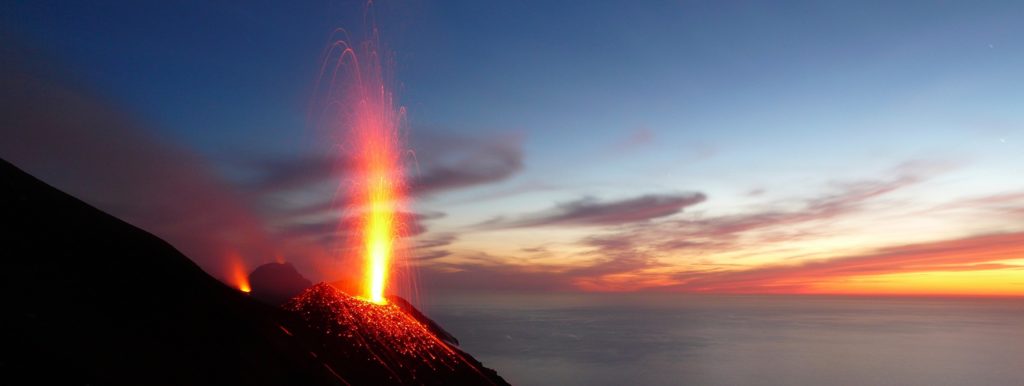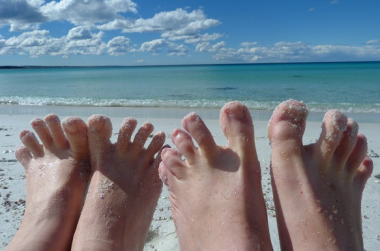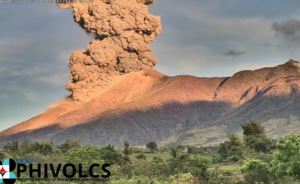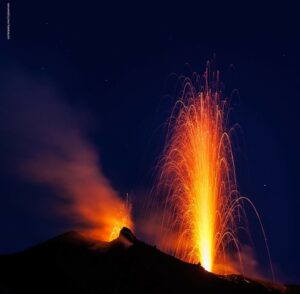July 08 , 2020.
Italy / Sicily , Etna :
Weekly bulletin from June 29, 2020 to July 05, 2020. (date of issue 07 July 2020)
SUMMARY OF ACTIVITY STATUS
In light of the monitoring data, it is emphasized:
1) VOLCANOLOGICAL OBSERVATIONS: Modest deep intra-crater strombolian activity and degassing of the New Southeast Crater. Degassing activity of the Bocca Nuova crater, the Voragine crater and the Northeast crater.
2) SEISMOLOGY: Low seismic fracturing activity; stationarity of the volcanic tremor parameters on high values.
3) INFRASOUND: Modest infrasound activity.
4) DEFORMATIONS: The Etna soil deformation monitoring networks did not show any significant changes last week.
5) GEOCHEMISTRY: the flow of SO2 is at a medium-low level.
The CO2 flow from the soil remains at average values, the partial pressure of dissolved CO2 does not show significant variations.
The C / S values are averaged (last measurement on 06/19/2020) The isotopic values He confirm the downward trend (last update on 06/12/2020).
6) SATELLITE OBSERVATIONS: The thermal activity in the summit area is low.
VOLCANOLOGICAL OBSERVATIONS
During the week, monitoring of volcanic activity in the summit craters of Etna was carried out by analyzing images from the network of surveillance cameras from the INGV Catania section, Etneo Observatory (INGV-OE) and using an inspection carried out by INGV-OE staff on July 3.
During the period under review, the upper craters were mainly characterized by degassing activities. Modest deep intra-crater strombolian activity persists in the New Southeast Crater (NSEC). In particular, observations made during the inspection on July 3 showed that the pit crater formed at the center of the depression of the crater of Bocca Nuova is affected by a slight degassing from the bottom. Fumarole systems have also developed in the southern sector of the bottom of the crater and also along the streams which poured from the Voragine crater (VOR) in Bocca Nuova until the end of April.
The Voragine crater is affected by a modest degassing of the main ash cone. The northeast crater shows degassing from the bottom which, sometimes (July 2), was accompanied by weak strombolian intra-crater activity.
Finally, during the week, a modest intra-crater strombolian activity continued from the mouths of the “saddle cone” of the New Southeast Crater. This activity does not produce hot matter visible on the surface, but produces an incandescence at night, which is associated with an intense pulsed degassing.
Volcanic tremors:
The temporal trend of the average amplitude of the volcanic tremor remained at a high level throughout the week. The source of the tremor was constantly located in the area of the New Southeast Crater, at a depth of about 2900-3000 meters above mean sea level.
Source : INGV .
Read the entire article : http://www.ct.ingv.it/index.php/monitoraggio-e-sorveglianza/prodotti-del-monitoraggio/bollettini-settimanali-multidisciplinari/349-bollettino-settimanale-sul-monitoraggio-vulcanico-geochimico-e-sismico-del-vulcano-etna20200707/file
Photos : INGV. / Alessandro Bonforte et Emanuela De Beni .
Italy , Stromboli :
Weekly bulletin from June 29, 2020 to July 05, 2020. (date of issue 07 July 2020)
SUMMARY OF ACTIVITY STATUS
In light of the monitoring data, it is emphasized:
1) VOLCANOLOGICAL OBSERVATIONS: During this period, a normal strombolian-type explosive activity was observed accompanied by degassing and splashing activities. The total hourly frequency of explosions fluctuated between average values (10 events / h on July 3) and high values (21 events / h on June 29). The intensity of the explosions was variable from low to high both in the area of the North crater and in the area of the Center-South crater.
2) SEISMOLOGY: The seismological parameters do not show significant variations.
4) DEFORMATIONS: The island’s soil deformation monitoring networks did not show any significant variation to report for the period considered.
5) GEOCHEMISTRY: the flow of SO2 is at a medium-low level
There are no updated values of the CO2 / SO2 ratio in the plume. The last measurement relating to 06/28/2020 was of low value.
The He isotopic values of the last update (9/06/2020) are in the average.
6) SATELLITE OBSERVATIONS: The thermal activity in the summit area is at a moderate level.
Fig. 3.1 – The crater terrace seen by the thermal camera located on the Pizzo above the Fossa with the delimitation of the crater zones of the Center-South and North zone (ZONE N, ZONE C-S respectively).
Abbreviations and arrows indicate the names and locations of the active vents, the area above the crater terrace is divided into three height ranges related to the intensity of the explosions.
VOLCANOLOGICAL OBSERVATIONS
During the observation period, the eruptive activity of Stromboli was characterized by the analysis of images recorded by the INGV-OE surveillance cameras (190 m, Punta del Corvi, 400 m and Pizzo). The explosive activity was mainly produced by 3 (three) eruptive vents located in the area of the North crater and by 3 (three) eruptive vents located in the area of the Center-South crater. All the mouths are placed inside the depression which occupies the terrace of the crater. Due to the unfavorable visibility conditions of July 5, the observation of the explosive activity was not sufficient for a correct description of the explosive activity.
Fig. 3.2 – Photograph taken in the morning of July 1, 2020 from the Pizzo by D. Andronico. The abbreviations in white indicate the denomination of the active craters.
On July 1 and 2, an inspection was carried out in the summit area by researchers from the INGV-OE in Catania to make observations from the Pizzo Sopra la Fossa on the explosive activity and the morphology of the craters. In the area of the North crater, the crater N1 produced an activity from 2 mouths, one located on the bottom of the crater and the other consisting of a small hornito at the edge of the crater overlooking the Sciara del Fuoco. The activity consisted of strombolian explosions from the hornito, for a few tens of seconds, sometimes accompanied by ash emissions from the bottom of the crater. The crater N2 was mainly characterized by prolonged gas emissions associated with strong explosions and sometimes with modest expulsions of magma flaps. Large vertical jets of light ash accompanied by lithic blocks, reaching over 150 m in height, were generated at crater S1.
Central crater C was characterized by abundant degassing and modest splash activity. Finally, crater S2 was composed of a large and deep depression, in which
at least 2 adjacent vents were present, with explosive activity varying with strong Strombolian explosions with the launch of lithic blocks as well as ash emissions and violent gas emissions.
The crater N1 located in the North zone, with two emission points, produced explosions mainly of medium and sometimes high intensity (the products of certain explosions exceeded 200 m in height) emitting coarse materials (lapilli and bombs) which fell abundantly with a radial distribution. The N2 mouth showed an explosive activity of low intensity (less than 80 m in height) emitting fine materials (ash) sometimes mixed with large ones. The average frequency of explosions was between 5 and 12 events / h.
In the Center-South zone, the mouth S1, located on the cone overlooking the Sciara, produced explosions of low and medium intensity of coarse material while the mouth located in the crater S2 produced explosions of intensity variable from low to high emitting coarse matter mixed with fines.
The vents located in zone C continuously produced intense splashing activity, sometimes interrupted by explosions of coarse materials of low intensity. The frequency of
the explosions oscillated between 5 and 9 events / h.
Source : INGV.
Photo : stromboli adventures
Return MONDAY…


